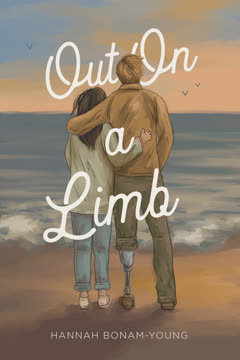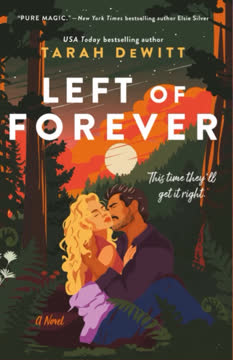Plot Summary
Seventeen Years, One Love
Sarah and Caleb's story begins in the chaos of adolescence, where a chance encounter at school sparks a connection that will shape their lives. Their bond is immediate, deepened by shared humor, mutual support, and the comfort of being seen. As they navigate the turbulence of growing up—family struggles, first loves, and the ache of wanting more—their relationship becomes a lifeline. Sarah's world is colored by her mother's resilience and her own longing for purpose, while Caleb's gentle steadiness offers her a safe harbor. Their love, forged in the fires of youth, is both a blessing and a burden, setting the stage for a lifetime of togetherness before either truly knows themselves.
Fundraiser, Failure, Fracture
In the present, Sarah organizes a high-stakes fundraiser in memory of her late mother, desperate to prove her worth and find meaning. The event, meant to be a triumph, instead exposes her insecurities and the cracks in her marriage. When the fundraising goal falls short, Caleb quietly intervenes, saving the night but undermining Sarah's need for independence. The gesture, though well-intentioned, ignites a painful argument—Sarah feels erased, her efforts rendered meaningless, while Caleb is bewildered by her anger. Their roles as rescuer and rescued, helper and helped, become suffocating. The night ends with unresolved tension, both questioning if love is enough when selfhood is lost.
Marriage on Pause
Weeks pass in a cold war of avoidance. Sarah and Caleb, once inseparable, now orbit each other with caution and resentment. Sarah confides in her best friend Win, voicing fears of being a background character in her own life, defined only by her marriage. Win, ever the anchor, urges her to seek change, suggesting a couples' wilderness retreat—Reignite—as a last-ditch effort to reconnect. The idea is met with skepticism but also a flicker of hope. Both Sarah and Caleb realize that something fundamental must shift, or their marriage may quietly dissolve under the weight of unspoken disappointments and unmet needs.
Childhood, Caretaking, Choices
Flashbacks reveal the roots of Sarah's struggles: a childhood marked by her mother's illness, early caretaking, and the abrupt end of her own ambitions. Winning a writing contest once filled her with hope, but a harsh critique from her idol crushed her confidence. As her mother's ALS progresses, Sarah's world narrows to survival and support, her own desires buried beneath duty. Caleb, steadfast and loving, becomes her partner in grief and adulthood, but their early marriage is shaped by necessity, not choice. The past lingers, shaping Sarah's sense of self and her fear that she's never truly lived for herself.
Into the Wild Unknown
Sarah and Caleb arrive at Reignite, a weeklong wilderness retreat for couples. Stripped of technology and comfort, they join a motley group of strangers, each with their own baggage. The rules—no sex, no distractions—force them to confront their patterns and vulnerabilities. The physical challenges of hiking mirror their emotional exhaustion, but small moments of humor and connection begin to thaw the ice between them. Sarah's longing for independence clashes with her fear of failure, while Caleb's desire to help is both a comfort and a cage. The woods become a crucible, testing the strength and flexibility of their bond.
Strangers, Rules, and Rain
The group dynamic at Reignite is a microcosm of relationship struggles: infidelity, communication breakdowns, and the search for meaning. Sarah and Caleb's interactions with others—especially the wise, enigmatic leaders Helen and Yvonne—highlight their own issues. The enforced abstinence rule (later revealed as a prank) adds tension and humor, while the relentless rain and physical discomfort strip away pretenses. Sarah's insecurities surface in group therapy, her fear of being unremarkable and her resentment of always being the one helped. Caleb, meanwhile, is forced to reckon with his own avoidance and the ways he's failed to see Sarah's pain.
Hiking, Hurting, Healing
The days blur into a rhythm of hiking, aching muscles, and shared meals. Sarah and Caleb rediscover the joy of inside jokes and playful banter, even as old arguments resurface. The physical hardship becomes a metaphor for the emotional work they must do—pushing through discomfort, supporting each other, and learning to rest. Sarah's vulnerability in group sessions is met with empathy, not judgment, and she begins to see that her struggles are not unique. The woods, once intimidating, become a place of tentative healing, where honesty and effort matter more than perfection.
Confessions in the Woods
One-on-one sessions with Helen and Yvonne force Sarah and Caleb to articulate their deepest fears and desires. Sarah admits her longing for a life that is hers alone, not just an extension of Caleb's. She confronts the grief and anger she's carried since her mother's death, and the way it has shaped her choices. Caleb, in turn, reveals his terror of change and his belief that their old life was enough. Both realize that their roles—helper and helped—have become prisons. Through guided exercises and raw conversation, they begin to imagine a future built on mutual growth, not codependence.
Therapy, Truths, and Tension
The retreat's exercises—communication games, journaling, and forced vulnerability—bring buried resentments to the surface. A public argument exposes the depth of their frustration and the pain of feeling unseen. Yet, for the first time, anger is not a threat but a catalyst for honesty. Sarah and Caleb apologize, not just for recent hurts but for years of misunderstanding. They exchange gestures of care—flowers, notes, and small acts of service—rebuilding trust one moment at a time. The woods, once a place of exile, become a sanctuary for new beginnings.
Breaking Patterns, Building Bridges
As the retreat nears its end, Sarah and Caleb break the abstinence rule, rediscovering physical intimacy as an expression of emotional closeness. They share their ten-year dreams: Sarah wants to write again, to reclaim the ambition she abandoned; Caleb wants to restructure his company, prioritize people over profit, and live more simply. Both commit to therapy, to downsizing, and to being present for each other and their chosen family. The group's support and the lessons of the woods give them the courage to return home and face the world as partners, not savior and saved.
The Accident and Aftermath
On the final hike, a sudden accident shatters the fragile peace. Caleb, in an act of selfless bravery, is injured while rescuing a child. The trauma plunges Sarah into a familiar nightmare—hospital waiting rooms, helplessness, and the specter of loss. Old wounds reopen, but this time, Sarah finds strength in her community: Win, Bo, and even Caleb's difficult family rally around her. The ordeal forces Sarah to confront her relationship with faith, grief, and the limits of control. In the ICU, she learns to let go—not of hope, but of the belief that she must always be rescued.
Hospital Nights, Family Ties
The hospital becomes a crucible for all the relationships in Sarah's life. She and Win revisit old wounds and reaffirm their unbreakable bond. Caleb's mother, Chellie, is forced to confront her own emotional barriers, while Sarah finally stands up to Caleb's absent father. The long hours of waiting are filled with small acts of love, humor, and solidarity. When Caleb finally wakes, the relief is overwhelming. The experience cements their commitment to living fully, loving fiercely, and not wasting another moment on fear or regret.
Recovery, Reconnection, Resolve
Caleb's recovery is slow but steady, marked by gratitude and a renewed sense of purpose. Together, he and Sarah make good on their promises: scaling back work, prioritizing family, and supporting each other's dreams. Sarah applies to university, determined to write again. Caleb restructures his company, choosing people over profit. Their home becomes a haven for friends and family, a place where love is chosen daily. The lessons of the woods—honesty, effort, and presence—become the foundation of their new life.
Ten Years Forward
A decade later, Sarah and Caleb's life is rich with meaning, laughter, and chosen family. Sarah is a published author and playwright, her work inspired by her mother and her own journey. Caleb is a devoted partner, friend, and advocate for change. Their marriage, once threatened by stagnation and resentment, is now a partnership of equals—rooted in mutual respect, growth, and joy. Surrounded by friends, nieces, and a rescue dog named Helen, they celebrate the messy, beautiful life they've built. The story ends not with perfection, but with the promise of more: more love, more growth, and more living.
Characters
Sarah Green Linwood
Sarah is the emotional heart of the story—a woman shaped by early responsibility, grief, and the longing to be more than a supporting character in her own life. Raised by a resourceful single mother, Sarah's adolescence is marked by caretaking and the premature loss of her mother to ALS. Her early marriage to Caleb is both a comfort and a constraint, offering safety but stifling her sense of independence. Sarah's psychological journey is one of reclaiming agency: she must confront her fear of failure, her resentment of being helped, and her buried ambitions. Through therapy, friendship, and crisis, she learns to define herself not by what she's lost or whom she loves, but by her own choices and desires. Her arc is one of hard-won self-acceptance and the courage to live fully.
Caleb Linwood
Caleb is Sarah's high school sweetheart and eventual husband, a man whose kindness and reliability are both his greatest strengths and his biggest flaws. Raised in a privileged but emotionally distant family, Caleb finds purpose in helping others—especially Sarah. His role as the "fixer" becomes a double-edged sword, providing stability but also enabling Sarah's dependence and stifling her growth. Caleb's psychological struggle centers on his fear of change and his belief that love means protection. The wilderness retreat and subsequent crisis force him to confront his own needs, vulnerabilities, and the ways he's failed to see Sarah as a whole person. By relinquishing control and embracing mutual growth, Caleb evolves from savior to true partner.
Win (Winnifred)
Win is Sarah's lifelong best friend, a woman whose own challenges—disability, single motherhood, and relentless ambition—make her both a mirror and a foil for Sarah. Win's resilience and directness provide Sarah with both comfort and tough love. She is the voice of reason, urging Sarah to seek change and supporting her through every crisis. Win's relationship with her husband Bo and their daughter August exemplifies the messy, joyful reality of chosen family. Psychologically, Win represents the possibility of thriving after trauma and the importance of honest, enduring friendship.
Bo
Bo, Win's husband, is a source of warmth, humor, and stability. His easygoing nature and deep affection for his family make him an essential part of Sarah and Caleb's support system. Bo's presence is a reminder that masculinity can be nurturing and that vulnerability is a strength. He is the first to offer help, the last to judge, and the glue that holds the extended family together.
Helen
Helen, one of the retreat leaders, is a model of wisdom earned through hardship. Her calm, nurturing presence and practical advice help Sarah and Caleb break through their emotional barriers. Helen's own history of loss and resilience provides a template for healing, while her humor and groundedness keep the group anchored. She represents the possibility of growth at any age and the value of intentional community.
Yvonne
Yvonne, Helen's wife and co-leader, brings a blend of empathy, insight, and gentle provocation. Her therapy sessions with Sarah and Caleb are transformative, pushing them to articulate their deepest fears and desires. Yvonne's own grief—raising her granddaughter after her daughter's death—adds depth to her understanding of loss and resilience. She embodies the power of presence, acceptance, and the belief that healing is possible even after profound pain.
Libby
Libby, Helen and Yvonne's granddaughter, is a poignant reminder of the enduring impact of grief. Her initial anger and withdrawal give way to moments of connection, especially with Sarah, who recognizes her own younger self in the girl. Libby's journey from isolation to tentative trust parallels Sarah's own healing, and their bond is a testament to the power of shared experience and gentle guidance.
Maggie and Phil
This older couple at the retreat serve as both comic relief and role models. Their long marriage, marked by honesty, humor, and mutual respect, offers a vision of what lasting love can look like. Maggie's artistic pursuits and Phil's coaching background add texture to the group dynamic, while their willingness to share vulnerabilities helps normalize struggle and imperfection.
Nina and Jai
Nina and Jai, a younger couple at the retreat, embody the challenges of new relationships—secrets, miscommunication, and the fear of commitment. Their struggles serve as a foil for Sarah and Caleb, highlighting the universality of relationship issues across ages and stages. Nina's ambition and Jai's charm add energy and contrast, while their eventual honesty inspires others to do the same.
Chellie and Cyrus Linwood
Caleb's parents represent the emotional coldness and emphasis on achievement that shaped his worldview. Chellie's inability to express vulnerability and Cyrus's absenteeism are both obstacles and catalysts for Caleb's growth. Their eventual softening and attempts at connection underscore the possibility of change, even in the most entrenched relationships.
Plot Devices
Nonlinear Narrative, Interwoven Timelines
The novel's structure alternates between present-day crises and formative moments from Sarah and Caleb's past. This nonlinear approach allows the reader to see how childhood wounds, early love, and unresolved grief shape adult choices. Flashbacks provide context for current struggles, deepening empathy and highlighting the cyclical nature of healing. The interwoven timelines also create suspense, as revelations from the past reframe present conflicts.
The Wilderness Retreat as Crucible
The Reignite retreat is both setting and metaphor—a place where comfort is stripped away, forcing participants to confront their patterns and pain. The rules (no sex, no technology) and group therapy sessions create artificial constraints that heighten tension and accelerate growth. The retreat's structure—hiking, journaling, group exercises—serves as a narrative engine, propelling characters toward confrontation and, ultimately, transformation.
Symbolism of Rescue and Independence
Throughout the novel, acts of rescue—both literal and emotional—are central. Caleb's compulsion to save, Sarah's resentment of being saved, and the final act of physical rescue in the woods all serve as metaphors for the dynamics of their marriage. The breaking of these patterns is both a plot point and a psychological breakthrough, symbolizing the shift from codependence to partnership.
Group Therapy and Confession
The retreat's group sessions and one-on-one therapy provide a narrative device for characters to voice their fears, regrets, and hopes. These confessions, often prompted by wise mentors, allow for catharsis and connection—not just between Sarah and Caleb, but among the entire group. The device also enables the author to explore universal themes of love, loss, and self-acceptance.
Humor and Inside Jokes
Despite heavy themes, the novel is laced with humor—banter, running gags, and playful teasing. These moments of levity serve as emotional relief, deepen intimacy between characters, and remind the reader that joy and pain coexist. The use of inside jokes, especially between Sarah and Caleb, underscores the depth of their shared history and the possibility of rediscovering delight even in hard times.
Letters, Notes, and Gestures
When words fail, characters turn to gestures—paper airplanes, flowers, shared meals, and small acts of service. These devices externalize internal shifts, marking moments of forgiveness, gratitude, and renewed commitment. The recurring motif of the paper airplane, from teenage flirtation to adult reconciliation, encapsulates the enduring power of simple, intentional acts.
Analysis
Out of the Woods is a deeply contemporary exploration of love, loss, and the search for self within the context of a long-term relationship. Hannah Bonam-Young's novel interrogates the myth of the "happily ever after," revealing that even soulmates must continually choose each other—and themselves—amidst the evolving challenges of adulthood. The story is a love letter to those who met their person before meeting themselves, and to anyone who has felt frozen by trauma or defined by caretaking. Through its nonlinear structure, the book deftly illustrates how the past shapes the present, and how healing is rarely linear. The wilderness retreat serves as both literal and metaphorical crucible, forcing characters to confront the patterns that bind and suffocate them. Ultimately, the novel champions vulnerability, honest communication, and the courage to change—not just for the sake of a relationship, but for one's own fulfillment. Its message is both hopeful and realistic: love is not a static state, but a dynamic, ongoing act of mutual growth, forgiveness, and presence. In a world obsessed with achievement and perfection, Out of the Woods reminds us that it is enough to simply be, to try, and to love imperfectly but wholeheartedly.
Last updated:
Review Summary
Out of the Woods receives mostly positive reviews, with readers praising its emotional depth, realistic portrayal of marriage, and character development. Many found the story relatable and appreciated the exploration of self-discovery within a long-term relationship. The book's handling of grief and communication issues resonated with readers. Some criticism focused on pacing and character decisions. Overall, reviewers found it a touching and impactful read, with many considering it a favorite or highly recommending it.
















